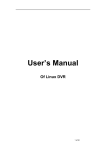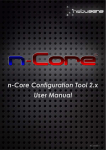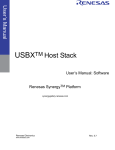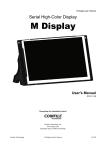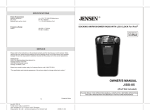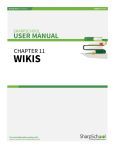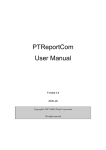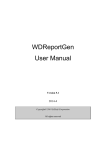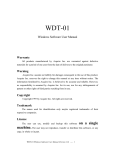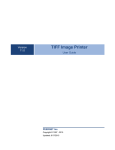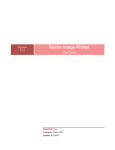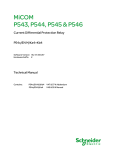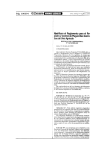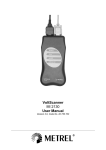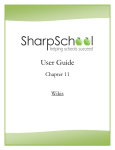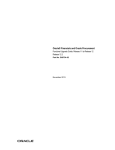Download User Manual - Informatik Inc.
Transcript
TiffDLL50
ActiveX DLL
Informatik Inc.
User Manual
May 31, 2007
Print out this manual for easy reference.
1
Table of Contents
Installation.............................................................................................................3
Important Message ...............................................................................................3
Trial Version..........................................................................................................3
Use of TiffDLL in your Application.........................................................................4
Parameter Syntax .................................................................................................5
Parameters ...........................................................................................................7
Split/Combine Files .............................................................................................20
Printing................................................................................................................21
Error Codes ........................................................................................................24
License Fees ......................................................................................................26
Technical Support ...............................................................................................26
Distribution to End-Users ....................................................................................26
Copyright ............................................................................................................27
License Agreement .............................................................................................27
Appendix:............................................................................................................29
Member Method, Object Method: ............................................................................29
Index ...................................................................................................................31
2
Installation
Click on the setup.exe or setupex.exe file and follow the prompts.
The VB version of TiffDLL50 requires the VB Runtime file msvbvm60.dll. The
standard download file includes then VB runtime file. If the file is missing please
contact Informatik Inc.
Important Message
As with all programs that change files, be sure that you make a full backup of
your files before you use TiffDLL. Once a file has been changed, the action
cannot be undone. Also, if at all possible, use different file names for the output
files (i.e. do not overwrite the source files); only delete the source files once you
have verified that the output files are correct. The TiffDLL program is very
powerful and versatile, but if used incorrectly it can damage or destroy your files.
Test your application fully before you use TiffDLL in a production environment.
TiffDLL is supplied AS IS and the developer, copyright holder, supplier assume
no responsibility. Please also read the Licensing Agreement section below. Do
not use the program if you do not agree with the licensing terms and the
disclaimers.
Trial Version
If you are using the Trial Version, please note the following important restrictions:
1. The trial version requires that the output file name be different than the
source file. This requirement has been added to ensure that the user is
not accidentally deleting or damaging source files names. Still, it is
important that you make a full backup of your files before you use the
TiffDLL program.
2. All output images are marked ‘TRIAL VERSION TIFFDLL’.
3
Use of TiffDLL in your Application
TiffDLL is not a Control, it is an ActiveX DLL (apartment-threaded). Please consult
your programming language’s user and reference manual for instructions on how to
integrate the ActiveX DLL into your application’s code. For a command-line driven
version of TifDLL50 please contact Informatik.
For Visual Basic applications, proceed as follows:
From the Projects (or Tools) menu, choose References and mark the TiffDLL50
checkbox, then click on OK.
If the list of References shows MISSING:TiffDLL50, un-check the item, click on OK,
choose References again from the Projects menu, and you will find the correct TiffDLL50
reference.
In your application, insert one of the sample codes shown below (VB code). The
download file also includes a SAMPLE.VBP project file. With the sample_test.exe utility
you can test and experiment with the parameter strings without creating a project.
There are two methods of using the ActiveX DLL:
The Parameter Method: All specifications are embedded into a single parameter string
in accordance with a strict syntax. The function is then called with the parameter string
as the argument. This is the recommended method; it is easier to implement, and the
descriptions of the parameters shown below use that method.
The Member Method, Object Method: The individual properties of the object are set
before the function is called. The Member method is covered in detail as an appendix at
the end of this manual
Parameter Method:
Sample Code for VB (using Parameter Method):
(For other programming languages, please see sample code in www.Informatik.com/files.html)
‘(General) Declaration
Private obj As TiffDLL50vic.ClsTiffDLL50
Private Sub Form_Load()
Set obj = New TiffDLL50vic.ClsTiffDLL50
End Sub
Private Sub Command1_Click()
Dim result As Long
Dim Param As String
param = "in=c:\mydir\img1.bmp;
out=c:\dir2\TIFFDLLTEST.TIF; format=tif/14"
result = obj.RunTiffDLL (param)
End Sub
4
Private Sub Form_Unload(Cancel As Integer)
Set obj = Nothing
End Sub
The function returns zero (0) if successful. If you set the Test parameter to 2 (test=2),
then the number of pages processed are returned. If the return value is negative, it
represents an error code (see below for a list of error codes).
Because the functions have is a very large number of parameter elements the TiffDLL
deviates somewhat from the general ActiveX DLL format. You only enter ONE
parameter string. The single parameter string includes all the specifications (properties).
For the syntax of the parameter string please see the sections below.
For splitting multi-page TIFF files into single-page files, and to combine files
into a multi-page Tiff file see the Split/Combine Files section below.
For Printing, see Printing section below.
Parameter Syntax
(Parameter Method)
The parameter string (arguments) consists of a number of elements, such as
source file, output file, graphics format, etc. Each element is separated by a
semi-colon. In turn, most parameter elements are divided into sub-components,
separated by the slash symbol (/).
The TiffDLL function can handle several conversions at the same time; for
example you can change the size of the image, add a text annotation and a
watermark with one command. Some conversions cannot be run at the same
time and you need to run two functions in sequence. An error code –9003 or –
3242 generally indicates that you are using a combination of conversions that is
incompatible. Also, if you are using color images you may be restricted to the
number of transformations within one function call.
Example of a simple parameter string:
In=c:\dir1\filex.tif;out=c:\dir2\TIFFDLLTEST.TIF;format=tif
/14;text=0/2/1/Sample
This sample parameter string specifies the following: File c:\dir1\filex.tif will be
opened and saved as file c:\dir2\filez.tif, as a TIFF format 14. The text ‘Sample’
will be annotated at the top, right-adjusted, opaque. For now, don’t worry about
the codes; everything is explained below. Just note how the parameter elements
are separated by semi-colons and that many of the parameter elements have
5
sub-items separated by the slash symbol (/). Note also, that each parameter
elements has a name tag followed by an equal sign (=). There must not be a
space between the name tag and the equal sign. ‘In=’ is correct, but ‘in =’ is
incorrect.
To summarize:
•
•
•
•
•
•
•
•
•
The parameter string has many parameter elements.
The order of the parameter elements is irrelevant.
Most parameters are optional. Only the parameter elements that are
relevant need to be included, but you can include blank parameter
elements.
Each parameter elements has a name tag followed by an equal sign (=).
There must never be a space between the name tag and equal sign,
otherwise spaces are irrelevant.
The strings are not case sensitive. In= is the same as IN= or in=.
Many parameter elements have sub-items, separated by the slash symbol
(/). All leading sub-items must be entered, but lagging items my be
omitted. Blank sub-items must also be separated by a slash symbol.
Text strings (for example in text=) should not be enclosed in quotes.
Semi-colons always separate the parameter strings; so never use a semicolon inside a text string (for example in text=).
For debugging, add a test=1; to the parameter string, like:
test=1; in=c:\file.tif;out=c:\TIFFDLLTEST.TIF;format=tif/14
Printing is done with the ‘out=’ parameter. Please see also Printing section
below.
To retrieve the properties of images (number of pages, width, height, resolution,
color, etc., use the ‘out=’ parameter.
To retrieve the software license number, run the function in test mode, like:
test=1
Please note that when you convert a graphics file memo-type tags are not
retained and are lost.
6
Parameters
If you use the Parameter Method, each parameter element must be preceded
with the label followed by the equal sign (no space between the label and the
equal sign).
If you use the Object Method, do not use the label and the equal sign; enter only
the value string.
test=
Example:
test=2;
If the Test parameter is set to 2 (test=2) the conversion will be executed and the
function will return the number of processed pages. If the return value is
negative, the return code represents an error code.
in=
Example:
in=c:\somedir\somefile.tif;
This parameter specifies the source document. The entry must be a fullyqualified path name of an existing file. Do not use a semi-colon character in the
file name.
out=
Examples:
out=c:\somedir\somefile.tif;
out=c:\somedir\somefile.tif;
out=c:\somedir\xfile[+001].tif;
out=print/ 6/1/1;
out=info_w;
(If you are using a TRIAL VERSION, the output file (out= parameter) must gave a
different name than the source name (in= parameter). This is for precautionary
reasons so that when testing the DLL you are not accidentally overwriting the
source files.
7
This parameter specifies the output file, print specifications or file information
specifications. Do not use a semi-colon character in the file name.
To save a file, the entry must be a fully-qualified path name and the folder
(directory) must exist. You must have read/write permission for the specified
folder.
To split a multi-page TIFF file into single-page files (TIFF or other graphics
formats) use the numeric placeholder [+0001]. Include a sufficient number of
leading zeros to accommodate all the pages.
To print the reformatted image, use the ‘print’ specifier. The print specifier
consists of the keyword ‘print’ followed by up to six (6) optional print specification
values. For instructions, please see Printing section below.
To return the detail of the image file properties use one of the following
keywords:
•
•
•
•
•
•
•
Out=info1 (or info_p) returns the number of pages in the image file
Out=info2 (or info_w) returns width of image in pixels
Out=info3 (or info_h) returns height of image in pixels
Out=info4 (or info_x) returns xresolution (horizontal resolution)
Out=info5 (or info_y) returns yresolution (vertical resolution)
Out=info6 (or info_c) returns color depth (bits-per-pixel)
Out=info7 (or info_t) returns Tiff compression code
1 No compression
2 CCITT Group 3
3 Fax compatible Group 3
4 Fax compatible Group 4
5 LZW
6 JPEG
7 JPEG
32773 PackBits
pages=
Examples:
pages=0-5;
pages=5;
pages=5-7;
pages=15-9999;
For multi-page graphics files you can specify a range of pages to be processed.
To specify an unknown last page, use a very high number, e.g. 9999.
8
You can obtain the number of pages in a TIFF file with the Out=info_p
parameter string (see section on the Out= parameter above.
save=
Example:
save=1;
This parameter specifies how the output files are saved if the file name already
exists.
The parameter values are:
•
•
0=Overwrite without warning
1=Append as additional page
Generally, you should only append to TIFF files previously created by this
software. If you append to TIFF files created by other software, carefully review
the resulting TIFF. In any case make sure that you have made a backup of such
TIFF files.
format=
Example:
format=tif/14;
The Format parameter string is optional. If not specified, the extension name of
the output file will determine the format type and the compression type will be
inherited or adapted from the source file, if appropriate.
The Format parameter consists of two sub-items: the format type and the
compression type.
The available format strings are:
(For processing TIFF files with a large number of pages use codes tif/51, tif/54 or
tif/53 (Tifftek32 is version 6.1 or higher and for TiffDLL50 version 5.61 or higher
only)).
Format=tif/0
Format=tif/1
Format=tif/2
Format=tif/3
(uncompressed TIFF, multiple strips)
(TIFF/LZW, multiple strips)
(TIFF Packbits, multiple strips)
(TIFF 3, multiple strips)
9
Format=tif/4
Format=tif/5
Format=tif/10
Format=tif/11
Format=tif/12
Format=tif/13
Format=tif/14
Format=tif/15
Format=tif/23
Format=tif/24
Format=tif/25
Format=tif/33
Format=tif/34
Format=tif/35
(TIFF 4, multiple strips)
(TIFF CCITT 3, multiple strips)
(uncompressed TIFF, single strip)
(TIFF/LZW, single strip)
(TIFF Packbits, single strip)
(TIFF 3, single strip)
(TIFF 4, single strip)
(TIFF CCITT 3, single strip)
(TIFF 3, FillOrder=2)
(TIFF 4, FillOrder=2)
(TIFF CCITT 3, FillOrder=2)
(TIFF 3, single strip, FillOrder=2)
(TIFF 4, single strip FillOrder=2)
(TIFF CCITT 3, single strip, FillOrder=2)
Format=bmp/0
Format=png
Format=pcx
Format=tga/0
Format=tga/1
Format=jpg/75
Format=gif
Windows Bitmap, uncompressed
PNG format
PCX format
Targa, uncompressed
Targa, compressed
JPEG, 75% quality (use range between 1-99)
GIF format
For TIFF Class F (Dialogic) use format code 35 (or 34), resolution 204x196 and
width of 1728 pixels.
colors=
Example:
colors=8;
The colors= parameter can be used to reduce the color depths of an image (bitsper-pixel). The following values are available:
•
•
•
1=
8=
-8 =
Monochrome (black and white)
8-bit color (256 colors) using color palette
8-bit grayscale (minus 8)
Only 24-bit colors are supported for JPEG files.
If you reduce color images to monochrome you may want to use the
DitherMethod (dither=). See below.
10
dither=
Example:
dither=2;
If a color image is reduced to monochrome (black and white) the system will
apply a standard dithering method. You can change or disable dithering with a
setting as follows:
•
•
•
0=
1=
2=
Standard scatter dithering (Default)
Ordered dither method
Threshold method (essentially no dithering)
Dithering can have a significant effect on performance.
size=
Example:
size=8/11;
This parameter resizes the image (both image and dimensions)
The two sub-parameter values are:
Width:
Width in inches
If ‘pix’ or ‘p’ is appended to the value (e.g. 600pix), then width is taken in pixels.
If ‘%’ is appended to the value (e.g. 50%), then width is taken as percentage of
original width.
Height:
Height in inches
If ‘pix’ or ‘p’ is appended to value (e.g. 600pix), then height is taken in pixels.
If ‘%’ is appended to value (e.g. 50%), then height is taken as percentage of
original height.
Only one sub-parameter needs to be specified (width or height); the system can
calculate the other sub-parameter (retaining the original width/height
relationship). If you only specify the height, make sure that you precede the
height value with a slash symbol (e.g. size= / 11).
One inch is equivalent to 2.5 centimeters. Be sure you use the appropriate
decimal symbols (period or commas)!
11
Examples:
Size=8/11;
Size=1000pix/1200pix;
Size=8;
Size=50%;
canvas=
Example:
canvas=8/14;
This parameter resizes the dimensions of the image (the ‘canvas’), without
resizing the inside image. This option is useful to increase the bottom margin, or
to change a letter size file to a legal size file.
The three sub-parameter values are:
Width:
Width in inches
If ‘pix’ or ‘p’ is appended to value (e.g. 600pix), then width is taken in pixels.
If ‘%’ is appended to value (e.g. 50%), then height is taken as percentage of
original width.
Height:
Height in inches
If ‘pix’ or ‘p’ is appended to value (e.g. 600pix), then height is taken in pixels.
If ‘%’ is appended to value (e.g. 50%), then height is taken as percentage of
original height.
One inch is equivalent to 2.5 centimeters. For JPEG files use number of pixels
instead of inches. Be sure you use the appropriate decimal symbols (period or
commas)!
Color of canvas:
If set the 1, the background color will be set to black. This option is rarely used.
12
Examples:
canvas=8/14;
canvas=1000pix/1200pix;
canvas=8/14;
canvas=50%;
canvas=8/14/1;
res=
Example:
res=204x196;
res=204/196;
This parameter specifies the horizontal and vertical resolution for TIFF files.
The values (separated by an ‘x’ or a slash symbol) are:
•
•
Horizontal resolution
Vertical Resolution
move=
Examples:
move=1/1;
move=-1;
This parameter shifts the image horizontally or vertically, i.e. in increases or
reduces the margins, without changing the width and height of the image. This
function is useful if you need to add space at the bottom to insert a text
annotation (and you have space to spare at the top). A negative value moves
the image left or up; a positive value moves the image right or down.
The two sub-parameter values are specified in inches. One inch is equivalent to
2.5.centimeters. Be sure you use the appropriate decimal symbols (period or
commas)!
1. Horizontal shift
2. Vertical shift
For JPEG files the values must be specified in pixels (not inches or centimeters).
13
crop=
Examples:
crop=1/2/4/5;
crop=0/0.5/4/5;
This parameter specifies the cropping rectangle.
The four sub-parameter values are specified in inches. One inch is equivalent to
2.5.centimeters. Be sure you use the appropriate decimal symbols (period or
commas)!
1.
2.
3.
4.
Left offset
Top offset
Right
Bottom
For JPEG files the values must be specified in pixels (not inches or centimeters).
rotate=
Examples:
rotate=90;
rotate=1;
This parameter specifies the rotation angle:
•
•
•
•
•
90 = 90-degree clockwise rotation
180 = upside-down rotation
270 = 90-degree counter-clockwise rotation
-90 = Conditional 90-degree rotation *
-270 = Conditional 270-degree rotation *
If width (pixels) is larger than height
You can also enter
1 for a 270 degree rotation,
2 for a 90 degree rotation, and
3 for a 180 degree rotation.
If you enter a non-square angle, the command will be ignored.
14
Generally, rotate functions should be run alone and cannot be combined with
other graphics transformation.
invert=
Example:
invert=1;
This parameter inverts the image (negative copy).
flip=
Example:
flip=1;
This parameter flips the image (vertical mirroring).
mirror=
Example:
mirror=1;
This parameter creates a mirror image (horizontal flip).
text=
Examples:
text=-1/1/0/Sample Text;
text=-1/1/0/Page [p] of [pp];
This parameter specifies the placement and text of single-line annotations. For
multiple text inserts (e.g. form filling) please use the ‘multitext=’ parameter (see
below), or run the ‘text=’ function several times in sequence.
15
The four (4) sub-parameters are:
Vertical placement (in pixels):
If the value is positive, the specified position is relative to the top of the image; if
the value is negative (e.g. –12), the specified position is relative to the bottom of
the image. To place text at the bottom of the image, you typically would specify a
minus 1 ( -1 ).
Alignment:
0 = Left adjust (default)
1 = Centered
2 = Right adjust
Transparency:
1 = Opaque (default)
0 = Transparent
Text:
The text can include the following placeholders/merge fields:
[D] inserts the current date in the format specified in the Windows setup (short
date format).
[F] inserts the file base name.
[FF] inserts the file name, including the extension.
[FFF] inserts the full path of the file name.
[P] inserts the page number.
[F], [FF] and [FFF] will print the file names in capital letters. To print lower-case
characters use [f], [ff] and [fff] instead.
Example of text sub-parameter: Hello World
File: [FFF] Page: [P]
Date: [D]
Example of complete text parameter: text=-12,1,1,Hello World;
If you need to insert text at a specific horizontal location (pixel denominated) or
if you need to insert rotated text, use the Multitext= parameter (see below).
Do not use a semi-colon character in the text string.
16
multitext=
Example:
multitext=c:\somefile\textinsert.txt;
This option can be used to annotate several text fields at different locations. The
parameter must specify a text file that contains all the specifications. Do not use
a semi-colon character in the file name.
The specification file must be an ASCII text file with the following 6 parameter
elements:
1.
2.
3.
4.
5.
6.
Horizontal offset in pixels
Vertical offset in pixels
Font
Transparency: 0=Transparent, 1=Opaque (default)
Rotation (1-360) (not supported by all fonts)
Text
The Font specification uses similar syntax as the Font= parameter (see below).
For example 12bc uses font size 12 Bold Courier. Special font names can be
specified inside parenthesis (see example below).
Example of a specification file:
0/0/12c/0/0/Hello World
50/0/12hb///More text
100/0/12h/0/45/Confidential
100/0/12h(Century Gothic)/0/45/Confidential
font=
Examples:
font=12buh;
font=24
font=12iu/Stencil
This parameter specifies the font used for the text annotation (text=).
A single-string parameter specifies both the font name, font size and font
attributes.
17
The leading numeric value represents the font size. The suffix letters specify the
font type and attributes. The letters can be entered in any order. The available
suffix letters are (lower-case or upper-case):
•
•
•
•
•
•
H = Helvetica font (default)
C = Courier font
R = Times Roman font
B = Bold
U = Underline
I = Italic
Optionally (rarely required) you can add a second parameter element and
request a specific font name.
image=
Example:
image=100/100/1/c:\somedir\image123.bmp;
This parameter specifies the position and bitmap image overlay (e.g.
watermarks).
The four sub-parameter values are:
1. Left offset in pixels
2. Top offset in pixels
3. Transparency:
0 = Transparent (default)
1 = Opaque
2 = Reversed
4. Image file name (overlay image). Must be full path name of a BMP or a
TIFF file. Do not use a semi-colon character in the file name.
first=
Example:
first=1;
If set to 1, only the first page of a multi-page TIFF file will be converted. The
remaining pages will be appended unchanged (some tags may be omitted).
18
DeletePg=
Example:
deletepg=3;
If the specified value is a valid page number, this page will be deleted. If you
need to remove several pages, you should re-build the file by iterating (looping)
thru the pages, or use the pages= parameter.
19
Split/Combine Files
For splitting multi-page TIFF files into single-page files, a) specify a numeric
placeholder in the [+nnn] format, or b) determine the number of pages in the TIFF
file and loop thru the number of pages and save each page to a unique file name.
See VB code snippets below.
To combine files into a multi-page Tiff file, iterate thru each file and append the
file to a common destination file name. See VB code snippet below.
Code snippets:
Partial code for splitting a multi-page file into a single-page file
Method 1
. . . . . . .
outfile = "c:\aaa\tiffdlltest\abc[+0001].tif"
param = "in=c:\xxx.tif;out=" & outfile & ";format=tif/14"
result = obj.RunTiffDLL(param)
. . . . . . .
Method 2
. . . . . . .
Param1 = "in=c:\xxx.tif;out=info_p"
nrpages = obj.RunTiffDLL(Param1)
For i = 1 To nrpages
outfile = "c:\aaa\tiffdlltest\abc" & Trim(Str(i)) & ".tif"
param2 = "in=c:\xxx.tif;pages=" & i & ";out=" & outfile &
";format=tif/14"
MsgBox param2
result = obj.RunTiffDLL(param2)
Next
. . . . . . .
Partial code for combining a single-page file into a multi-page file
. . . . . . .
Param1 = "in=c:\xyz.tif;out=c:\aaa\tiffdlltest\combined.tif;
save=1;format=tif/14"
result = obj.RunTiffDLL(Param1)
. . . . . . .
Partial code for combining some pages (last two pages) of a multi-page
file into another multi-page file
. . . . . . .
Param1 = "in=c:\document\3pages.tif;out=info_p"
nrpages = obj.RunTiffDLL(Param1)
For i = nrpages-2 To nrpages
param2 = "in=c:\xxx.tif;pages=" & i &
";out=c:\aaa\tiffdlltest\dest.tif;save=1;format=tif/14"
result = obj.RunTiffDLL(param2)
Next
. . . . . . .
20
Partial code for combining a multi-page file into another multi-page
file
. . . . . . .
param = "in=c:\xxx.tif ; out=c:\aaa\tiffdlltest.tif ; save=1
;format=tif/14"
result = obj.RunTiffDLL(param)
. . . . . . .
Printing
To print a page or a range of pages use the keyword ‘print’ in the out=
parameter (see out= section above). The pages to be printed can be specified
with the pages= parameter (see pages= section above). If the pages are not
specified, all pages of a multi-page TIFF file are printed.
The tree main parameter strings are, all optional:
1. Image width in inches (default = 8)
Set to minus 1 (-1) for ‘Size-to-Fit’. For some printers you may need to set
the value to –2 or even –3.
2. Left offset in inches (default = 0)
3. Top offset in inches (default = 0)
The printed image height is calculated by the system (scaled to specified width).
The print request is always sent to the default printer.
One inch is equivalent to 2.5 centimeters.
Examples:
Out=print
Out=print/ 6/1/1;
Out=print/ 6;
Note the slash symbol after the keyword ‘print’. In sample 2 printing is done with
a 1 inch left and top offset and the printed image width is 6 inches. Sample 3 will
print 6 inches wide without offsets (other than the non-printable areas). Sample
1 uses the 7.25 inch default width.
Unless specified different in the pages= parameter (see below), all pages of a
multi-page TIFF file are printed.
For more advanced settings (like paper size, bin, orientation) see the paragraphs
below.
Great care must be taken to ensure that the image fits into the printable area of
your printer. Keep in mind that most printers have a non-printable area on each
21
side of the paper (left, top, right, bottom). This means that a 8.5 inch image will
not fit on a 8.5 inch paper; the printable area for most printers would be between
7.5 and 8 inches. If the image is too large for the printable area, the printing
function will fail. The print size is specified in the out= parameter (see out=
section above). You can work around the non-printable area by cropping the
image by ¼ inch (for example) on all sides (see crop= function above). The
cropping function can be included in the print parameter string and it will not
affect the actual image file. This process will need some experimenting on your
part.
For advanced printing specification, the out= parameter sub-string has three (5)
additional values (fifth, sixth and seventh, eighth and ninths item in command
string). These are:
Letter size:
5 for Legal size
9 for A4 size
0, 1 or blank for letter size
For other sizes please see your printer manual
Paper Bin:
2 for lower bin
3 for middle bin
4 for manual insert
0, 1 or blank for upper bin
For other paper bin codes please see your printer manual
Orientation:
2 for Landscape
0, 1 or blank for Portrait
Printer Device:
(Exact spelling of printer name)
PrintJob:
Name of print job (optional)
For example:
In=c:\dir1\file.tif;out=print/7/0/0/5/4/2/Printer_XYZ/Job9;
will print a legal size paper (code 5) to the Manual paper bin (code 4) in
Landscape (code 2) on the printer Printer_XYZ as print job Job9
Other example:
22
In=c:\dir1\file.tif;out=print/7/0/0/////Job001;
If the TiffDLL50 does not close after a print job, run an ‘empty’ DLL50 call in an
application with a code such as:
Public obj As TiffDLL50Vic.ClsTiffDLL50
Private Sub Form_Load()
Set obj = New TiffDLL50Vic.ClsTiffDLL50
DoEvents
Set obj = Nothing
End
End Sub
Printing to networked printers:
If you are printing to a networked printer and the printing fails, check the
following: a) Make sure that the networked printer is correctly mapped. b) Test
and see if you can print the same document to a local printer. If it prints to the
local printer but not to the networked printer, it is likely a network setup problem.
If it does not print to the local printer, then review again the general printing
trouble-shooting. c) Reduce the scale of the print. It is possible that the
networked printer has a larger non-printable area and requires a reduced print
scale. d) If it still does not print, then review the Spool Settings of the networked
printer (In the printer control panel, choose Detail tab in Properties window and
click on Spool Settings button). Check the ‘Print directly to printer’ box.
23
Error Codes
Error code –9001 means that in TRIAL VERSION the output file name (out=)
must not be the same as the source file name (in=). This is for precautionary
reasons so that when testing the DLL you are not accidentally overwriting the
source files.
The function returns the number of pages processed. If the return value is negative, it
represents an error code. If you run in Test mode (test=1) the conversion is not
executed and the function returns a zero (0).
Common Error Codes:
-3242 Combination of incompatible conversions;
split the conversion into two function calls.
-3799 Invalid printer name
-9001 In Trial version, the destination file name cannot be the same
as the source file name (for precautionary reasons).
-9002 Output filename must be different than source filename.
-9003 There are incompatible functions within the command line.
Run some of the functions separately.
-9004 For multipage files, the destination file name cannot be the same
as the source file name.
Specific Error Codes:
The first two digits represent TiffDLL errors (mainly input and syntax errors) and
the last two digits represent Tifftek32 Library error codes (mainly graphics
processing errors).
TiffDLL Error Codes (first two digits of the 4-digit error code):
10.. Input file not specified
11.. Output file not specified
12.. Annotation text not specified
13.. Watermark image file not specified
20.. Unable to get image data
21.. Image data for watermark file (must be .bmp format)
22.. Load watermark file (must be .bmp format)
23.. BitBlt error
24.. Memory Allocation
25.. DrawText error (annotations)
26.. Resize image
24
27.. Unable to open multitext spec file
29.. TextOut multitext
31.. Cropping
32.. Save file error
34.. Resize canvas
37.. Printing
38.. Convert Bits0per-Pixel, Palette
Tifftek32 Library Error Codes (last two digits of the 4-digit error code):
00
01
02
03
04
05
06
08
09
10
11
12
14
16
17
18
19
25
26
27
33
34
40
41
42
43
44
45
46
47
48
49
50
51
52
No error
Range error
Digitizer board not detected
Disk full, file not written
Filename not found
Variable out of range
Unreadable TIFF format
TIFF bits per sample not supported
Unreadable compression scheme
Cannot create file (Make sure the folder exists)
Unknown file format
Image is compressed DIB
Insufficient memory for function
Unreadable PCX format
Unreadable GIF format
Print error
Scanner error
Unreadable TGA format
Bits per pixel not supported
Unreadable BMP format
No data from device
Function timed out
Could not lock memory (invalid handle or memory discarded)
Print function already executing
Invalid image buffer address. (See above for error –3242)
Unreadable JPEG format
Image is too complex for operation
Paper could not be unloaded
ADF lid was opened
ADF bin is empty
ADF is not connected
ADF is connected but not ready
Function not available due to missing module
Page not found
Pointer does not point to readable or writable memory
25
53
Informatik)
54
55
56
57
58
59
60
61
62
63
64
65
66
67
68
69
99
LZW compression/decompression not enabled (Contact
Could not create TWAIN parent window
Could not open TWAIN Source Manager
Could not open TWAIN Data Source
TWAIN image acquisition error
None of the elements in two lists were equal
Data type mismatch
User canceled scan
TWAIN function is busy
File contains invalid data
Unreadable PNG format
PNG compressor error
No ACK from device
TWAIN ADF is empty
Stop scanning images
Handle not valid
TIFF file is in Motorola byte order
Invalid printer name
License Fees
Please see www.Informatik.com/tiffdll.html or contact Informatik Inc. For contact
information please visit www.Informatik.com/company.html
Technical Support
Please see www.Informatik.com/support.html
Distribution to End-Users
The following files must be included with your distribution:
•
•
•
TiffDLL50.DLL (must be registered in the Windows Registry)
Tifftek32.dll
VB6 runtime
26
Copyright
Copyright 2001-2003 Joseph Buchmann. All rights reserved.
License Agreement
Please read this License Agreement carefully before you install and use the
software. By installing and using the software you agree with the terms and
conditions of this License Agreement. If you do not agree with the terms and
conditions you must uninstall the software.
This License Agreement ("Agreement") is a legal agreement between Informatik
Inc., Devon Pennsylvania, USA ("Licensor") and you, the user ("Licensee"), and
becomes effective on the day the Licensee installs the software. This Agreement
covers all materials associated with this software, including, without limitation, the
downloadable files relating to this software, printed and online documentation,
and any additional supporting files and programs (herein, the "Software").
1. GRANT OF LICENSE
Licensor hereby grants to you, and you accept, a nonexclusive license to use the
Software on a specified number of computers/workstations owned, leased, or
otherwise controlled by you for personal or business purposes, and only as
authorized in this License Agreement. The Software may not be used on other
computers, nor may it be used by, or transferred to, other computers over a
network. Unless the Licensee purchased a server license, the Software may not
be installed on a server, or on a PC/workstation that acts as a server. Hosting a
batch service on a server, PC or workstation requires a server version. A site
license permits the installation of the Software on an unlimited number of
PC/workstations at one site for the enterprise.
The Software is used in the Licensee’s own application (“Application’). The
standard version of the Software allows the Licensee to distribute the Application
to and install it on a maximum of twenty-five end-user PCs and/or workstations
(not servers). The royalty-free version of the Software allows the Licensee to
distribute the Application and install it on an unlimited number of PCs,
workstations and/or servers. The Software must represent a relatively minor
part of that application. Under no circumstances must the Software be used to
create another toolkit, control, COM object or library, unless it is strictly used
internally by the Licensee under the terms of this license, and is not sold to or
used by third parties. A separate license for the Software is required for each
developer.
2. LICENSOR'S RIGHTS
Licensee acknowledges and agrees that the Software is proprietary to Licensor
and protected under international copyright law. Licensee further acknowledges
27
and agrees that all right, title, and interests in and to the Software, including
associated intellectual property rights, are and shall remain with Licensor. The
License Agreement does not convey to Licensee an interest in or to the
Software, but only a limited right of use that may be revoked in accordance with
the terms of this License Agreement.
3. OTHER RESTRICTIONS
Licensee agrees to make no more than one (1) back-up copy of the Software.
Licensee agrees not to assign, sublicense, transfer, pledge, lease, rent, or share
the rights assigned under this License Agreement. Licensee agrees not to
reverse assemble, reverse compile, or otherwise translate the Software.
4. TERM
This License Agreement is effective when Licensee installs the Software and
shall terminate only if the terms of this License Agreement are broken. Licensee
agrees to destroy the Software upon termination of this License Agreement.
5. NO WARRANTY; LIMITATION OF LIABILITY LICENSEE ACKNOWLEDGES
THAT THE SOFTWARE IS PROVIDED ON AN "AS IS" BASIS WITHOUT
WARRANTY OF ANY KIND. LICENSOR, DISTRIBUTORS OR AGENTS MAKE
NO REPRESENTATIONS OR WARRANTIES REGARDING THE USE OR
PERFORMANCE OF THE SOFTWARE. LICENSOR DISTRIBUTORS and
AGENTS EXPRESSLY DISCLAIM THE WARRANTIES OF MERCHANTABILITY
AND FITNESS FOR A PARTICULAR PURPOSE. LICENSOR, DISTRIBUTOR
OR AGENT SHALL HAVE NO LIABILITY TO LICENSEE OR ANY THIRD
PARTY FOR ANY LOSS OR DAMAGE CAUSED, DIRECTLY OR INDIRECTLY,
BY THE SOFTWARE, INCLUDING, BUT NOT LIMITED TO, ANY
INTERRUPTION OF SERVICES, LOSS OF BUSINESS, LOSS OF DATA OR
SPECIAL, CONSEQUENTIAL OR INCIDENTAL AMAGES.
6. GOVERNING LAW
The legal jurisdiction of this License Agreement shall be Pennsylvania, USA.
28
Appendix:
Member Method, Object Method:
Instead of defining a parameter string you can use the properties of the declared object.
In your application’s code, if you declared TiffDLL50.ClsTiffDLL as an object (named
‘obj’ in our example), simply type the name of the object (obj) followed by a period (.).
The programming interface will then display a list of all available properties. Pick the
relevant property and define it, as in the following example:
obj.File_In = ”c:\somedir\somefile.tif”
obj.File_Out = “c:\tiffdlltest\filexyz.tif”
obj.Format_Out = “tif/14”
etc.
The syntax of the object’s property string is identical to the string that you would use in
the parameter (except for the label; don’t use the label with the equal sign). See
Parameters section below.
Using the Object method, you run the function with a blank parameter, like
result = obj.RunTiffDLL (“”)
Sample Code for VB (using Object Method):
(For other programming languages, please see sample code in www.Informatik.com/files.html)
‘(General) Declaration
Private obj As TiffDLL50vic.ClsTiffDLL50
Private Sub Form_Load()
Set obj = New TiffDLL50vic.ClsTiffDLL50
End Sub
Private Sub Command1_Click()
Dim result As Long
obj.File_In = ”c:\somedir\somefile.tif”
obj.File_Out = “c:\tiffdlltest\filexyz.tif”
obj.Format_Out = “tif/14”
result = obj.RunTiffDLL (“”)
End Sub
Private Sub Form_Unload(Cancel As Integer)
Set obj = Nothing
End Sub
The properties of the object are (all string data types):
File_In (equivalent to in= in Parameter Method)
File_Out (equivalent to out= in Parameter Method)
Format_Out (equivalent to format= in Parameter Method)
29
Format_Colors(equivalent to colors= in Parameter Method)
DitherMethod(equivalent to dither= in Parameter Method)
SaveMethod (equivalent to save= in Parameter Method)
Size_Image (equivalent to size= in Parameter Method)
Size_Canvas (equivalent to canvas= in Parameter Method)
XYresolution (equivalent to res= in Parameter Method)
Image_Move (equivalent to move= in Parameter Method)
Image_Crop (equivalent to crop= in Parameter Method)
Image_Rotate (equivalent to rotate= in Parameter Method)
Image_Flip (equivalent to flip= in Parameter Method)
Image_Mirror (equivalent to mirror= in Parameter Method)
Text_Annotation (equivalent to text= in Parameter Method)
Text_Font (equivalent to font= in Parameter Method)
Text_MultiText (equivalent to multitext= in Parameter Method)
WatermarkImage (equivalent to image= in Parameter Method)
Page_FirstOnly (equivalent to first= in Parameter Method)
Page_Range (equivalent to pages= in Parameter Method)
TestMode (equivalent to test= in Parameter Method)
30
Index
annotations, 15
annotations (multiple items), 17
append pages, 9
Bates stamping, 15
BMP format, 9
borders, 13
canvas size, 12
color depths, 10
combine files, 20
combine files, multi-page, 20
cropping, 14
debugging, 6
Dialogic, TIFF Class F, 10
dimensions, paper, 12
distribution, files required, 26
error codes, 24
flip image, 15
fonts, 17
footers, 15
form filling, 17
format, 9
GIF format, 9
graphics format, 9
height, 11
installation, 3
invert image, 15
JPEG format, 9
length, 11
Letter size, 22
license agreement, 27
license fees, 26
license number.
LZW compression, 9
margins, 13
mirror image, 15
move image, 13
multi-page, 9
multi-page, combine, 20
multi-page, split, 8
multiple strips, 9
negative image, 15
Object Method, 29
offsets, 13
output file, 8
overlay image, 18
Packbits format, 9
page, first page only, 18
pages, number of, 8
pages, range of, 8
paper size, 12
Parameter Method, 4
Parameter Syntax, 5
parameters, 7
PCX format, 9
PNG format, 9
print, 8, 21
properties, 6, 8
resolution, 13
rotated text, 16, 17
rotation, 14
shift image, 13
single strips, 9
size, 11
software license, 6
source document, 7
split multi-page TIFF files, 8
splitting multi-page TIFF files, 20
syntax, 5
Targa format, 9
text annotations, 15
text annotations (multiple items), 17
TIFF Class F, 10
TIFF format, 9
Visual Basic, 4
watermarks, 18
width, 11
31































